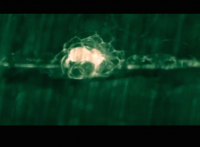 NEWS
NEWS
Time-lapse video of zebrafish lateral line wins first place in 4th Annual Nikon Small World in Motion Competition
CRG researchers Mariana Muzzopappa (currently working at IRB Barcelona) and Jim Swoger win the 4th Nikon Small World in Motion Competition with a time-lapse video of zebrafish lateral line development.
The awarded video was captured thanks to the Selective Plane Illumination Microscopy (SPIM), a new imaging technology that combines optical sectioning with multiple-view imaging. It allows one to observe tissues of large samples and living organisms with high resolution over extended periods of time, so it is perfect for developmental research projects.
Mariana Muzzopappa and Jim Swoger captured this video in order to study the development of the zebrafish lateral line, a sensory organ with hair cells, which are the same as humans have in our inner ear. So, understanding this process could provide insight into treating deafness in humans. The video shows how hair cells are differentiated and how the lateral line is developed throughout a 36-hour timeframe. Related research was already published in a paper in the Journal of Biophotonics on January 2011*.
Jim Swoger is a SPIM specialist at the Multicellular Systems Biology laboratory at the CRG. From the Optical Projection Tomography to the new SPIM 4D imaging, his work helps biologists to improve imaging technology and its use in developmental projects.
*Reference: Jim Swoger, Mariana Muzzopappa, Hernán López-Schier and James Sharpe. “4D retrospective lineage tracing using SPIM for zebrafish organogenesis studies” Journal of Biophotonics. January 2011. Volume 4, Issue 1-2, pages 122-134. DOI: 10.1002/jbio.201000087

